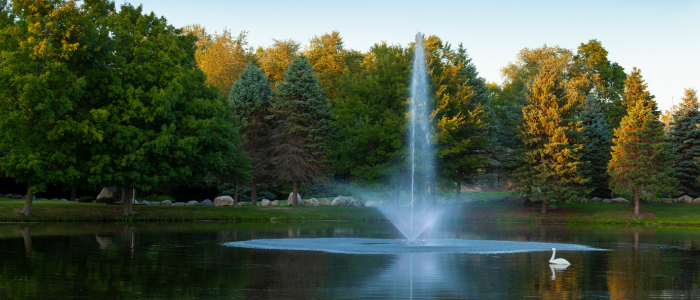It's a valid question, and one that we get often! Will a fountain aerate my pond?
The good news is that, in almost all cases, yes! A fountain can and will provide sufficient aeration for ponds. Let’s explore and compare some of the most common options for pond and lake aeration.
When it comes to effectively circulating water in your pond, there are a few options to consider.
Decorative Pond Fountains:
A decorative pond fountain is a visually captivating way to aerate a pond or lake. The sight of water cascading across the surface is not only aesthetically pleasing but also soothing to the ears. These fountains are an excellent choice for ponds that are not facing significant water quality issues but require a stylish and functional solution for preventative maintenance.
Aerating Fountains / Surface Aerators:
Aerating pond fountains / surface aerators provide a similar aesthetic appeal to decorative fountains, but they are capable of moving a larger volume of water each hour. These systems prevent water from entering the motor, functioning similarly to boat propellers. As a result, aerators do not create the intricate and varying spray patterns found in decorative fountains. We recommend these systems for ponds facing significant water quality issues at the surface, such as algae, duckweed, and the like.
Sub-Surface Aerators:
Sub-surface aerators operate beneath the water's surface. While they may not have the eye-catching features of floating fountains, they excel at moving stagnant water from the pond’s bottom. These systems are an option to consider if your pond is deeper than 10 FT and you are facing significant stratification & depleted oxygen levels deep within the pond.
It is important to note that sub-surface aeration systems are less forgiving than fountains & surface aerators, and they must be used carefully!
Using a sub-surface pond aerator can have some potential risks if not introduced gradually. Here are a few dangers to consider:
-
Disruption of Natural Stratification: Sub-surface aerators can mix the water layers, disrupting the natural stratification of the pond. While this might seem beneficial, it can cause cold, low-oxygen water from the bottom to rise to the surface, which can stress fish and other aquatic life that have adapted to the stable conditions.
-
Oxygen Depletion at Depth: If a sub-surface aerator is used too intensely or in the wrong locations, it can create an imbalance in oxygen distribution. This may cause oxygen levels to drop in the deeper layers where fish often reside, leading to hypoxic (low-oxygen) conditions.
-
Algae Growth: Aerating deeper water may increase the nutrient circulation throughout the pond, which can encourage algae blooms if the pond has high nutrient levels. These blooms can further deplete oxygen and harm the ecosystem.
-
Damage to Aquatic Life: The mixing of warm and cold water or the disturbance of sediment at the bottom of the pond can release harmful gases like hydrogen sulfide or ammonia that have built up in the deeper layers. This could harm or even kill fish and other organisms.
In Conclusion:
Overall, we find that the vast majority of pond owner's who experience issues with their water quality are facing problems at the surface, not the bottom of the pond. For this reason, we almost always suggest a fountain or surface aerator as a safe & reliable solution to agitate the surface level. Consider pairing your fountain or surface aerator with a beneficial bacteria treatment for maximum benefits!



